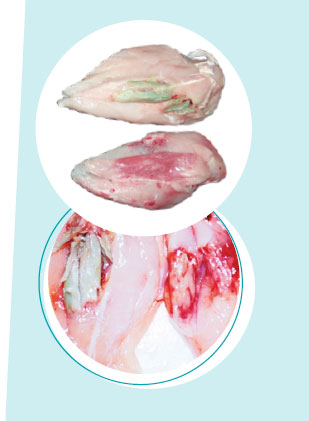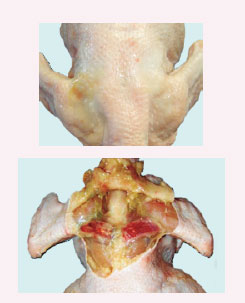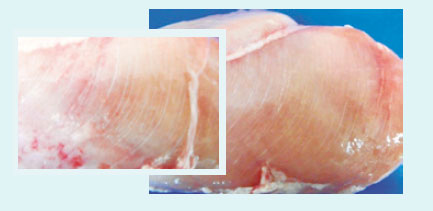Content available at: Español (Spanish)
Meat quality problems in slaughterhouses; related to injuries reminiscent to different types of myopathies, have been on the rise again in current time. These issues have been associated with the rapid growth of broilers due to advances in genetics and nutrition, which have led to spectacular transformation rates.
This type of problems detected in meat processing facilities have worried producers and have been the subject of various researches and publications in recent years.
We can highlight four main problems:
I. Deep pectoral myopathy.
II. Cranial dorsal myopathy.
III. Striated breast (White stripping).
IV. Spaghetti breast
I. Deep pectoral or supracoracoideus muscle myopathy.

it is considered as an ischemic-type myopathy .
It appears in meat type turkeys and chickens, but due more to ischemia than lactic acid, since this muscle is enclosed between the sternum and a thick inelastic fascia (EPIMYSIUM).
- When the muscle contracts due to excessive exercise, vascular compression ischemia occurs with necrosis in the central area.
The fiber appears with hyalinosis and transverse fragmentation, evolves to rapid necrosis and granulation tissue, with attempts at fiber regeneration and thrombosis (Randall, 1989).
The green coloration is due to the biliverdin formed after the bleeding.
ETIOLOGY
It was initially associated with poor handling and capture in the loading of birds at the farms, and was blamed on the intense flapping of the wings. In principle, it was observed only in meat processing facilities. In Spain, some cases were described at the end of the last century. (Pizarro, M .; Gimeno, I .; Valls, JL :; Martínez-Alesón, R .: “Deep pectoral myopathy in meat chickens: description of two slaughterhouse cases . ” Vet. In Madrid, 9 (37) : 26-31, 1997).
However, nowadays it is also observed in broiler and broiler breeder farms, mainly associated with rapid growth of the animals.

II.Cranial dorsal myopathy (Latissimus dorsi cranialis)
Injury observed in slaughterhouses with moderate incidence in broilers in Brazil and Europe. It is an economic problem because it results in seizures and low quality carcasses.
It is characterized by the appearance of muscular lesions in the dorsal cranial area in the anterior area of the latissimus dorsi, more specifically in the back / shoulder area of the chicken carcass.
Observing areas with a green and gelatinous appearance and edema or hemorrhage.
Yellowish discoloration, edema, swelling and bleeding after skin removal, the gelatinous aspect can be seen in the muscular areas of the cranial dorsal.
Hyalinosis and destruction of muscle fibers with massive inflammatory infiltrates in the interstitium.
III. Striated breast (white striping)
Has been observed in slaughterhouses and processing plants since 2013 .
It consists of a whitish striation between the muscle fibers, initially known as “White stripping”, which is commonly observed in the breast muscles (“Pectoralis major”); although it has been observed elsewhere, including the thighs.
In severe cases, it was also referred to as a woody breast syndrome or “Wooden muscle” , due to its wood-like grain (BROILER PROCESSING TIMELY INFORMATION – APRIL 2013, Broiler Chicken Myopathies: II. Woody Breast ?).

In a 2013 report from Auburn University, the first cases were reported: “Recent observations from numerous countries, including the United States of America, describe another type of myopathy that frequently affects the superficial pectoral muscle of the chicken meat, called wood breast or “Woody Breast” (Poultry Science Department, Auburn University, Auburn, AL 36849-5416 , www.ag.auburn.edu/dept/ph/).
Keep up to date with our newsletters
Receive the magazine for free in digital version
REGISTRATION
ACCESS
YOUR ACCOUNT
LOGIN
Lost your password?











